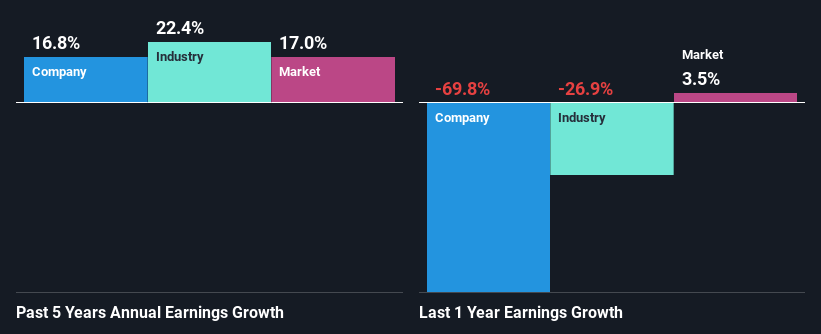Can Waypoint REIT (ASX:WPR) Performance Keep Up Given Its Mixed Bag Of Fundamentals?
Waypoint REIT's (ASX:WPR) stock up by 2.6% over the past week. However, the company's financials look a bit inconsistent and market outcomes are ultimately driven by long-term fundamentals, meaning that the stock could head in either direction. In this article, we decided to focus on Waypoint REIT's ROE.
Return on Equity or ROE is a test of how effectively a company is growing its value and managing investors’ money. Simply put, it is used to assess the profitability of a company in relation to its equity capital.
View our latest analysis for Waypoint REIT
How To Calculate Return On Equity?
The formula for ROE is:
Return on Equity = Net Profit (from continuing operations) ÷ Shareholders' Equity
So, based on the above formula, the ROE for Waypoint REIT is:
6.6% = AU$134m ÷ AU$2.0b (Based on the trailing twelve months to December 2022).
The 'return' is the amount earned after tax over the last twelve months. So, this means that for every A$1 of its shareholder's investments, the company generates a profit of A$0.07.
What Has ROE Got To Do With Earnings Growth?
We have already established that ROE serves as an efficient profit-generating gauge for a company's future earnings. Based on how much of its profits the company chooses to reinvest or "retain", we are then able to evaluate a company's future ability to generate profits. Generally speaking, other things being equal, firms with a high return on equity and profit retention, have a higher growth rate than firms that don’t share these attributes.
A Side By Side comparison of Waypoint REIT's Earnings Growth And 6.6% ROE
When you first look at it, Waypoint REIT's ROE doesn't look that attractive. We then compared the company's ROE to the broader industry and were disappointed to see that the ROE is lower than the industry average of 9.7%. Waypoint REIT was still able to see a decent net income growth of 17% over the past five years. So, the growth in the company's earnings could probably have been caused by other variables. For instance, the company has a low payout ratio or is being managed efficiently.
Next, on comparing with the industry net income growth, we found that Waypoint REIT's reported growth was lower than the industry growth of 22% in the same period, which is not something we like to see.
Earnings growth is an important metric to consider when valuing a stock. The investor should try to establish if the expected growth or decline in earnings, whichever the case may be, is priced in. Doing so will help them establish if the stock's future looks promising or ominous. Is WPR fairly valued? This infographic on the company's intrinsic value has everything you need to know.
Is Waypoint REIT Using Its Retained Earnings Effectively?
Waypoint REIT seems to be paying out most of its income as dividends judging by its three-year median payout ratio of 88%, meaning the company retains only 12% of its income. However, this is typical for REITs as they are often required by law to distribute most of their earnings. In spite of this, the company was able to grow its earnings by a fair bit, as we saw above.
Moreover, Waypoint REIT is determined to keep sharing its profits with shareholders which we infer from its long history of six years of paying a dividend. Upon studying the latest analysts' consensus data, we found that the company is expected to keep paying out approximately 100% of its profits over the next three years. As a result, Waypoint REIT's ROE is not expected to change by much either, which we inferred from the analyst estimate of 5.4% for future ROE.
Summary
In total, we're a bit ambivalent about Waypoint REIT's performance. While no doubt its earnings growth is pretty respectable, the low profit retention could mean that the company's earnings growth could have been higher, had it been paying reinvesting a higher portion of its profits. An improvement in its ROE could also help future earnings growth. With that said, the latest industry analyst forecasts reveal that the company's earnings growth is expected to slow down. To know more about the latest analysts predictions for the company, check out this visualization of analyst forecasts for the company.
Have feedback on this article? Concerned about the content? Get in touch with us directly. Alternatively, email editorial-team (at) simplywallst.com.
This article by Simply Wall St is general in nature. We provide commentary based on historical data and analyst forecasts only using an unbiased methodology and our articles are not intended to be financial advice. It does not constitute a recommendation to buy or sell any stock, and does not take account of your objectives, or your financial situation. We aim to bring you long-term focused analysis driven by fundamental data. Note that our analysis may not factor in the latest price-sensitive company announcements or qualitative material. Simply Wall St has no position in any stocks mentioned.
Join A Paid User Research Session
You’ll receive a US$30 Amazon Gift card for 1 hour of your time while helping us build better investing tools for the individual investors like yourself. Sign up here

